

Gold Rush - Classroom - BTN. The year was 1851, the place, a creek outside of Orange in New South Wales, when a man named Edward Hargraves made a huge discovery.
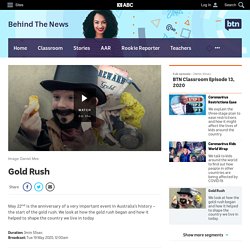
EDWARD HARGRAVES: It's gold. It was just five little flecks, but it was the start of a gold rush that would change the Australian colonies forever. It wasn't the first-time gold had been found in Australia. Since the early 1800s there had been small finds. Although authorities at the time didn't want to spread rumours of gold because they didn't trust the convicts that made up a lot of the population. GOVERNOR: Put it away Mr Clarke or we shall all have our throats cut. But their attitude changed pretty quickly in 1848, when the California Gold Rush began. History of Australia Online - Discovery of Gold in Australia. Australia 1851 was notable for the extension of representative Government to all the Australian colonies and for the first gold-field at Bathurst.
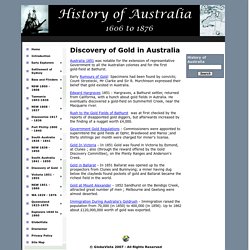
Early Rumours of Gold: Specimens had been found by convicts; Count Strzelecki, Mr Clarke and Sir R. Murchinson expressed their belief that gold existed in Australia. Edward Hargraves 1851 : Hargraves, a Bathurst settler, returned from California, with a hunch about gold fields in Autralia. He eventually discovered a gold-field on Summerhill Creek, near the Macquarie river. Children. As much as there may have been some opportunities for fun and fossicking, children would have suffered through the same basic living conditions and harsh weather on the goldfields.
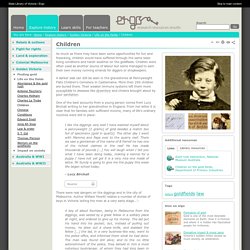
Children were often used as another source of labour but some managed to earn their own money running errands for diggers or shopkeepers. A darker side can still be seen in the gravestones at Pennyweight Flats Children's Cemetery in Castlemaine. More than 200 children are buried there. Their weaker immune systems left them more susceptible.
Australian Gold, History & Culture Info/Living Conditions On The Australian Gold Fields - Historic Gold Rush Village Mogo South Coast NSW Australia. Women worked from daylight to dark.

A typical day for a woman in an Australian pioneer village in the 1850s gold rush days, would be to rise at or before dawn and re-stoke the fire, using bellows to coax embers back to life. Dough that had been set to rise the night before would be kneaded again, then baked in the oven (if there was one in the settlers hut). Water would be set to boil and tea mashed. Breakfast was often rolled oats porridge. Once everyone was up, the sleeping rolls would be stored away and the chamber pot (guzzunder) emptied. A Child's Life. Sovereign Hill Education Blog. Growing up on the Victorian goldfields was tough, even for children from rich families.

If you had healthy parents, you could expect to have lots of brothers and sisters, and if they couldn’t afford to send you to school, you would be sent to work instead. Girls and boys experienced childhood quite differently back then, and if you had one or even two toys, you were a lucky child indeed! Ballarat Orphanage boot factory, date unknown. Reproduced with permission of the Gold Museum. Life on the goldfields was dangerous for children. 19th century goldrush families tended to be larger than Australian families today; having lots of children ensured that some survived to old age and were therefore able to look after their elderly parents (there was no pension to support senior citizens back then). Lollies – like our famous raspberry drops – were adult treats in the 19th century! Believe it or not, there was no free schooling in Victoria until the 1870s.
Gold Rush in Australia: About life on the goldfields from 1851. Towards the end of August 1851, James Reagan and John Dunlop discovered the richest goldfield the world has ever seen in a place the Aborigines called Balla arat, which means 'camping place', now the city of Ballarat.
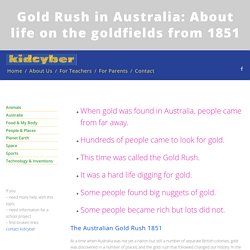
Other discoveries soon followed in Mount Alexander, now called Castlemaine, in Daylesford, Creswick, Maryborough, Bendigo and McIvor, now called Heathcote. Thousands of people left their homes and jobs and set off to the diggings to find their fortune. At the start of the gold rush, there were no roads to the goldfields, and no shops or houses there. People had to carry everything they needed.
They travelled by horse or bullock, or by walking with a wheelbarrow loaded with possessions. By the end of September 1851 there were about 10,000 people digging for gold near Ballarat. People came from all over the world, intending to strike it rich and return home to their own countries. Aborigines & the gold rush. Explorers and squatters had already disrupted traditional ways of life for Aboriginal people in the Victorian gold fields region.
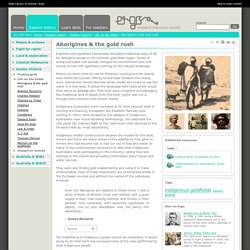
Flocks of sheep and cattle had already changed the environment and now crowds of men left significant scarring on the natural landscape. Miners cut down trees to use for firewood, housing and the boards that reinforced tunnels. The promise of gold. Race to the Gold Diggings of Australia is a boxed, children’s board game produced in England around 1855.

It is the earliest known board game that has Australia as its theme. Inside a printed wooden box is a brightly coloured game board (a linen-mounted, hand-coloured lithographic sheet), a printed sheet of rules, six ships made of painted metal and painted wood (to be used as counters), two dice, three wooden pegs, and a cardboard teetotum (spinning top). Gold Rush in Australia: About life on the goldfields from 1851. WA Goldfields.